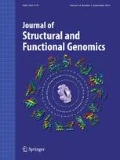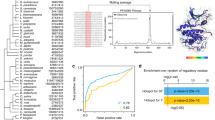Abstract
Phosphorylation and acetylation are the most prevalent post-translational modifications (PTMs) detected in not only eukaryotes but also bacteria. We performed phosphoproteome and acetylome analyses of proteins from an extremely thermophilic eubacterium Thermus thermophilus HB8, and identified numerous phosphorylation and acetylation sites. To facilitate the elucidation of the structural aspects of these PTM events, we mapped the PTM sites on the known tertiary structures for the respective proteins and their homologs. Wu et al. (Mol Cell Proteomics 12:2701–2713, 2013) recently reported phosphoproteome analysis of proteins from T. thermophilus HB27. Therefore, we assessed the structural characteristics of these phosphorylation and acetylation sites on the tertiary structures of the identified proteins or their homologs. Our study revealed that many of the identified phosphosites are in close proximity to bound ligands, i.e., the numbers of ‘nearby’ and ‘peripheral’ phosphorylation sites represent 56 % (48/86 sites) of total identified phosphorylation sites. In addition, approximately 60 % of all phosphosites exhibited <10 % accessible surface area of their side chains, suggesting some structural rearrangement is required for phosphoryl transfer by kinases. Our findings also indicate that phosphorylation of a residue occurs more frequently at a flexible region of the protein, whereas lysine acetylation occurs more frequently in an ordered structure.











Similar content being viewed by others
Abbreviations
- ASA:
-
Accessible surface area
- PTM:
-
Post-translational modification
References
Cohen P (2000) The regulation of protein function by multisite phosphorylation: a 25 year update. Trends Biochem Sci 25:596–601
Deribe YL, Pawson T, Dikic I (2010) Post-translational modifications in signal integration. Nat Struct Mol Biol 17:666–672
Moses AM, Landry CR (2010) Moving from transcriptional to phospho-evolution: generalizing regulatory evolution? Trends Genet 26:462–467
Macek B, Mijakovic I (2011) Site-specific analysis of bacterial phosphoproteomes. Proteomics 11:3002–3011
Kobir A, Shi L, Boskovic A, Grangeasse C, Franjevic D, Mijakovic I (2011) Protein phosphorylation in bacterial signal transduction. Biochim Biophys Acta 1810:989–994
Garnak M, Reeves H (1979) Phosphorylation of isocitrate dehydrogenase of Escherichia coli. Science 203:1111–1112
Hubbard MJ, Cohen P (1993) On target with a new mechanism for the regulation of protein phosphorylation. Trends Biochem Sci 18:172–177
Zhang H, Zha X, Tan Y, Hornbeck PV, Mastrangelo AJ, Alessi DR, Polakiewicz RD, Comb MJ (2002) Phosphoprotein analysis using antibodies broadly reactive against phosphorylated motifs. J Biol Chem 277:39379–39387
Oshima T, Imahori K (1974) Description of Thermus thermophilus (Yoshida and Oshima) comb. nov., a nonsporulating thermophilic bacterium from a Japanese thermal spa. Int J Syst Bacteriol 24:102–112
Yokoyama S, Hirota H, Kigawa T, Yabuki T, Shirouzu M, Terada T, Ito Y, Matsuo Y, Kuroda Y, Nishimura Y, Kyogoku Y, Miki K, Masui R, Kuramitsu S (2000) Structural genomics projects in Japan. Nat Struct Biol 7:943–945
Cava F, Hidalgo A, Berenguer J (2009) Thermus thermophilus as biological model. Extremophiles 13:213–231
Okanishi H, Kim K, Masui R, Kuramitsu S (2013) Acetylome with structural mapping reveals the significance of lysine acetylation in Thermus thermophilus. J Proteome Res 12:3952–3968
Takahata Y, Inoue M, Kim K, Iio Y, Miyamoto M, Masui R, Ishihama Y, Kuramitsu S (2012) Close proximity of phosphorylation sites to ligand in the phosphoproteome of the extreme thermophile Thermus thermophilus HB8. Proteomics 12:1414–1430
Wu W, Liao J, Lin G, Lin M, Chang Y, Liang S, Yang F, Khoo K, Wu S (2013) Phosphoproteomic analysis reveals the effects of PilF phosphorylation on Type IV pilus and biofilm formation in Thermus thermophilus HB27. Mol Cell Proteomics 12:2701–2713
Shrake A, Rupley JA (1973) Environment and exposure to solvent of protein atoms. Lysozyme and insulin. J Mol Biol 79:351–364
Kelley LA, Sternberg MJE (2009) Protein structure prediction on the web: a case study using the Phyre server. Nat Protoc 4:363–371
Lascu I, Gonin P (2000) The catalytic mechanism of nucleoside diphosphate kinases. J Bioenerg Biomembr 32:237–246
Ilag L, Videler H, McKay A, Sobott F, Fucini P, Nierhaus K, Robinson C (2005) Heptameric (L12)6/L10 rather than canonical pentameric complexes are found by tandem MS of intact ribosomes from thermophilic bacteria. Proc Natl Acad Sci USA 102:8192–8197
Hu CW, Lin MH, Huang HC, Ku WC, Yi TH, Tsai CF, Chen YJ, Sugiyama N, Ishihama Y, Juan HF, Wu SH (2012) Phosphoproteomic analysis of Rhodopseudomonas palustris reveals the role of pyruvate phosphate dikinase phosphorylation in lipid production. J Proteome Res 11:5362–5375
Costantini S, Colonna G, Facchiano AM (2006) Amino acid propensities for secondary structures are influenced by the protein structural class. Biochem Biophys Res Commun 342:441–451
Jiménez JL, Hegemann B, Hutchins JR, Peters JM, Durbin R (2007) A systematic comparative and structural analysis of protein phosphorylation sites based on the mtcPTM database. Genome Biol 8:R90
Weinert BT, Iesmantavicius V, Wagner SA, Scholz C, Gummesson B, Beli P, Nystrom T, Choudhary C (2013) Acetyl-phosphate is a critical determinant of lysine acetylation in E. coli. Mol Cell 51:265–272
Wolfe AJ (2010) Physiologically relevant small phosphodonors link metabolism to signal transduction. Curr Opin Microbiol 13:204–209
Lokanath NK, Shiromizu I, Ohshima N, Nodake Y, Sugahara M, Yokoyama S, Kuramitsu S, Miyano M, Kunishima N (2004) Structure of aldolase from Thermus thermophilus HB8 showing the contribution of oligomeric state to thermostability. Acta Crystallogr D Biol Crystallogr 60:1816–1823
Fushinobu S, Nishimasu H, Hattori D, Song HJ, Wakagi T (2011) Structural basis for the bifunctionality of fructose-1,6-bisphosphate aldolase/phosphatase. Nature 478:538–541
Kuchta K, Knizewski L, Wyrwicz L, Rychlewski L, Ginalski K (2009) Comprehensive classification of nucleotidyltransferase fold proteins: identification of novel families and their representatives in human. Nucleic Acids Res 37:7701–7704
Song H, Mugnier P, Das AK, Webb HM, Evans DR, Tuite MF, Hemmings BA, Barford D (2000) The crystal structure of human eukaryotic release factor eRF1—mechanism of stop codon recognition and peptidyl-tRNA hydrolysis. Cell 100:311–321
Fontecave M, Ollagnier-de-Choudens S (2008) Iron-sulfur cluster biosynthesis in bacteria: mechanisms of cluster assembly and transfer. Arch Biochem Biophys 474:226–237
Wada K, Sumi N, Nagai R, Iwasaki K, Sato T, Suzuki K, Hasegawa Y, Kitaoka S, Minami Y, Outten FW, Takahashi Y, Fukuyama K (2009) Molecular dynamism of Fe–S cluster biosynthesis implicated by the structure of the SufC(2)–SufD(2) complex. J Mol Biol 387:245–258
Fischer C, Geourjon C, Bourson C, Deutscher J (1996) Cloning and characterization of the Bacillus subtilis prkA gene encoding a novel serine protein kinase. Gene 168:55–60
Morita R, Ishikawa H, Nakagawa N, Kuramitsu S, Masui R (2008) Crystal structure of a putative DNA methylase TTHA0409 from Thermus thermophilus HB8. Proteins 73:259–264
Acknowledgments
This research was supported in part by Grant-in-Aid for Challenging Exploratory Research 25650008 (to RM). KY was supported by Platform for Drug Discovery, Informatics, and Structural Life Science from the Ministry of Education, Culture, Sports, Science and Technology (MEXT) of Japan.
Author information
Authors and Affiliations
Corresponding author
Rights and permissions
About this article
Cite this article
Masui, R., Takahata, Y., Inoue, M. et al. Structural insights of post-translational modification sites in the proteome of Thermus thermophilus . J Struct Funct Genomics 15, 137–151 (2014). https://doi.org/10.1007/s10969-013-9169-3
Received:
Accepted:
Published:
Issue Date:
DOI: https://doi.org/10.1007/s10969-013-9169-3




